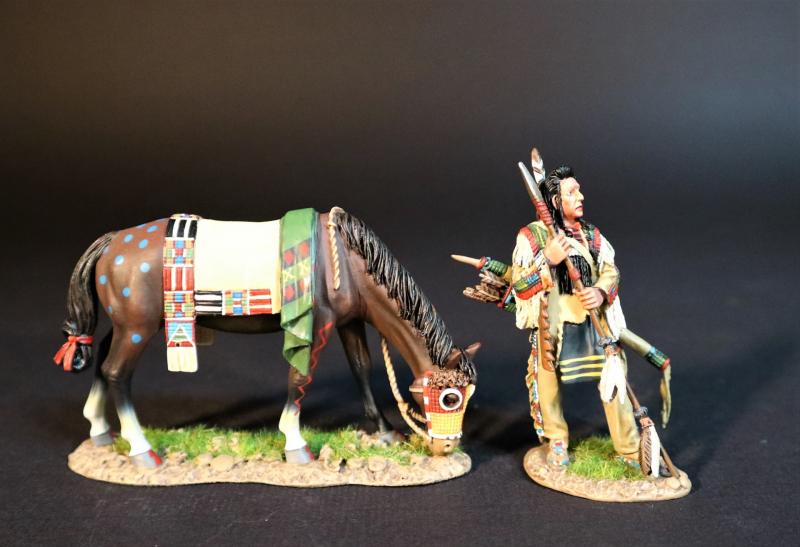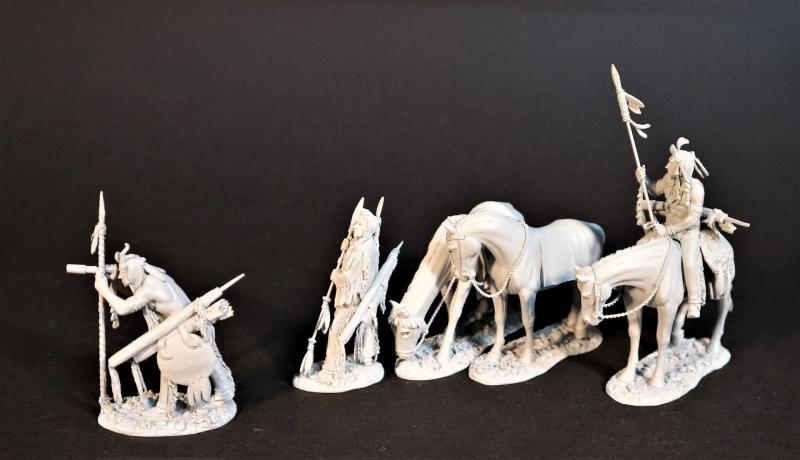Crow Warrior Scout, The Crow, The Fur Trade--single standing figure and grazing horse--RETIRED--LAST TWO!!
$118.00
Item Number: WSP-08A
Crow Warrior Scout, The Crow, The Fur Trade
CROW WARRIOR SCOUTS
Scouts were valued because of their specialized skills and knowledge acquired over a lifetime: knowledge of how to follow a trail and observe the enemy without being seen, knowledge of the country, and ability to identify vital information from tracks. These skills made it possible for soldiers operating in an alien environment to locate and surprise elusive enemies in their own country and greatly enhanced the ability of the military to carry out their mission.
Recruitment of Indian scouts was first authorized on July 28, 1866 by an act of congress.
"The President is authorized to enlist and employ in the Territories and Indian country a force of Indians not to exceed one thousand to act as scouts, who shall receive the pay and allowances of cavalry soldiers, and be discharged whenever the necessity for further employment is abated, at the discretion of the department commander.”
In the Indian wars following the U.S. Civil War, the Indian Scouts were a fast-moving, aggressive, and knowledgeable asset to the U.S. Army. They often proved to be immune to army notions of discipline and demeanor, but they proved expert in traversing the vast distances of the American West and providing intelligence—and often a shock force—to the soldiers who sought hostile Indians.
During the Indian wars, scouts were able to detect horse tracks where other soldiers could only detect hard ground. From these tracks, scouts could estimate the number of horses in a group. From the moisture content of horse dung, scouts could estimate the age of the trail. Scouts were also able to discern whether females rode with a group based on the position of a horse's urine within its tracks--women sometimes/often rode mares, while men rode stallions.
One of the most notable U.S. Army Indian Scouts was “Curley”, a member of the Crow tribe who became a scout in April 1876 under Colonel John Gibbon. He then joined Lieutenant Colonel Custer. Curley is most often identified as the lone survivor of “Custer’s Last Stand”. He denied witnessing the battle, although the Chicago Tribune published an article claiming that Curley had made statements to them about the battle. John F. Finerty claimed that “Curley said that Custer remained alive throughout the greater part of the engagement, animating his men to determined resistance, but about an hour before the close of the fight received a mortal wound”.
Signals were done in many ways, there were arm or hand signals, holding a lance, gun or robe. Mirrors or whistles were also used. There were two kinds of signals employed on the plains, those designed for close quarter communication, and those designed for signaling over long distances of a mile or more.
There were 3 long distance methods. The Body action, the action of the signaler in connection with objects, such as a robe, blanket, mirror, flag, or lance, or by smoke.
Smoke or mirror signals were used in daytime, with the number of flashes or puffs serving as a kind of morse code, and fires placed at intervals in rows accomplished the same thing at night. Smoke signals were made by letting the smoke rise in a single column, or by slipping a robe or blanket sideways over a fire made with dry wood and green grass or moss thrown on it.
Fire signals were made on high ridges or away from water so that it would be known they were not campfires.
Released in OCTOBER 2023.
RETIRED.
LAST TWO!!

